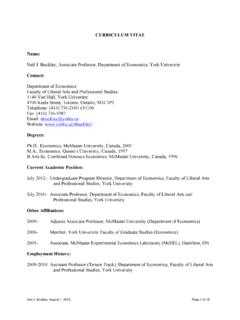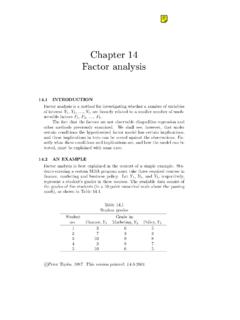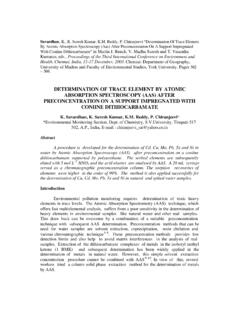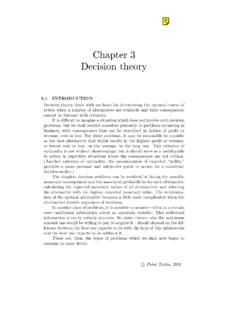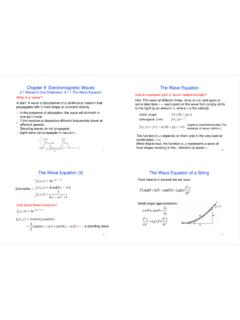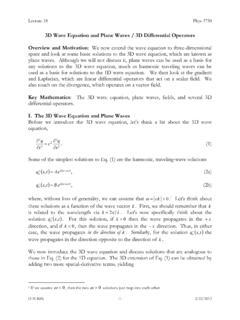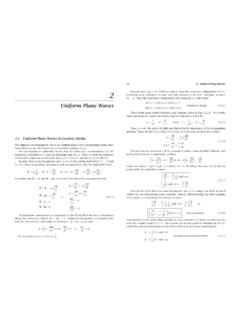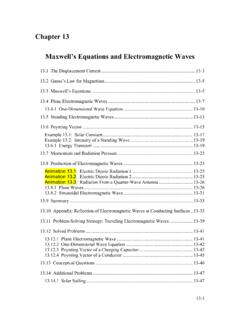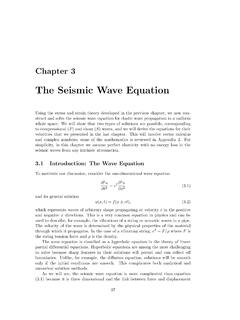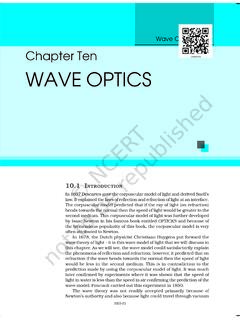Transcription of Lab 8: Polarization of Light - York University
1 Lab 8: Polarization of Light1 IntroductionRefer to Appendix D for photos of the appara-tusPolarization is a fundamental property of Light anda very important concept of physical optics. Not allsources of Light are polarized; for instance, Light froman ordinary Light bulb is not polarized. In addition tounpolarized Light , there is partially polarized Light andtotally polarized Light . Light from a rainbow, reflectedsunlight, and coherent laser Light are examples of po-larized Light . There are three different types of po-larization states: linear, circular and elliptical. Eachof these commonly encountered states is characterizedby a differing motion of the electric field vector withrespect to the direction of propagation of the lightwave. It is useful to be able to differentiate betweenthe different types of Polarization .
2 Some common de-vices for measuring Polarization are linear polarizersand retarders. Polaroid sunglasses are examples of po-larizers. They block certain radiations such as glarefrom reflected sunlight. Polarizers are useful in ob-taining and analyzing linear Polarization . Retarders(also called wave plates) can alter the type of polar-ization and/or rotate its direction. They are used incontrolling and analyzing Polarization experiment consists of a series of basic exercises,which will introduce important techniques for analyz-ing the Polarization of Light . We will study linear andcircular Polarization , using linear polarizers and twotypes of retarders: quarter-wave and half-wave. Thefirst two parts of the experiment deal with testing thepolarization of a laser and analyzing it using linearpolarizers. In the third part of the experiment, youwill use quarter wave plates to produce circularly po-larized Light and investigate its properties.
3 Finally,you will use a half-wave plate to rotate the directionof linear 1-5 PERTAIN TO THE BACK-GROUND CONCEPTS AND EXERCISES6-11 PERTAIN TO THE 1: (a)Oscillation of E vector, (b)An BackgroundLight is a transverse electromagnetic wave. Its prop - agation can therefore be explained by recalling theproperties of transverse waves . Picture a transversewave as traced by a point that oscillates sinusoidallyin a plane, such that the direction of oscillation isperpendicular to the direction of propagation of thewave. The oscillating point can be considered to de-scribe the vibration of the electric field vectorEofthe Light wave, as shown in Figure 1(a). The magneticfield vectorBvibrates in a direction perpendicular tothat of the electric field vector and to the directionof propagation of the wave, as shown in Figure 1(b).
4 The magnetic field is very weak and therefore it is ig-nored in our study of Polarization . In figures 1a and1b, only one electric field vector is shown. However, Light emitted from an actual source consists of manysuch electric field vectors. The Polarization of Light isdefined in terms of the direction of oscillation of theelectric field vectors. An ordinary source of Light (suchas the Sun) emits Light waves in all directions. Conse-quently, the electric field vectors vibrate randomly inall directions. Such sources of Light areunpolarized(Figure 2(a)).Partially polarizedlight occurs ifthe E vectors have a preferred direction of oscillation(Figure 2(b)). Light istotally linearly 2: Polarization of Light , z is the direction of propagation .(orplane polarized) if all the electric field vectorsoscillate in the same plane, parallel to a fixed directionreferred to as the Polarization direction.
5 The specialcase of vertically polarized Light is represented by avertical arrow (Figure 2(c)), while the special case ofhorizontally polarized Light is represented by a dot in-dicating that the E vector oscillates into and out ofthe page (Figure 2(d)). For linearly polarized Light ,the plane of Polarization is defined as a plane paral-lel both to the direction of oscillation of the electricfield vector and the direction of propagation of thewave. The behavior of electromagnetic waves can bestudied by considering twoorthogonalcomponentsof the electric field vector. The phase relationship be-tween these two components can explain the differentstates of Polarization . For example, if the phase rela-tionship is random, Light is not polarized. If the phaserelationship is random, but more of one component ispresent, the Light is partially polarized.
6 If the phaserelationship is constant, the Light is completely polar-ized. More specifically, if the phase difference is 0 or180 degrees, the Light islinearlypolarized. If thephase difference is 90 or 270 degrees and both compo-nents have the same amplitude, the Light iscircularlypolarized. If a constant phase difference other than 0,90, 180 or 270 degrees exists and/or the amplitudesof the components are not equal, then the Light isel-lipticallypolarized. In case of circular or ellipticalpolarization, the plane of Polarization rotates, in con-trast to linear Polarization where the plane of polar-ization is fixed. There are two directions of circularly(or elliptically) polarized Light . Right-hand circularlypolarized Light is defined such that the electric fieldis rotating clockwise as seen by an observer towardswhom the wave is moving.
7 Left-hand circularly po-larized Light is defined such that the electric field isrotating counterclockwise as seen by an observer to-wards whom the wave is Polarization is not studied in this experi-Figure 3: Transmission through a linear A mathematical treatment of linear and circu-lar Polarization and their interaction with polarizersand retarders will be presented polarizers:Certain materials have the prop -erty of transmitting an incident unpolarized Light inonly one direction. Such materials are called sheets (which aredichroic) are manufac-tured by stretching long-chained polymer moleculesafter which they are saturated with dichroic materialssuch as iodine. Then they are saturating with dichroicmaterials such as iodine. The direction perpendicularto the oriented molecular chains is called thetrans-mission axisof the polarizer.
8 A polarizing sheet hasa characteristicpolarizing directionalong its trans-mission sheet transmits only the com-ponent of the electric field vector parallel toits transmission component perpendic-ular to the transmission axis is completely absorbed(this is called selective absorption). Therefore, lightemerging from the polarizer is linearly polarized in thedirection parallel to the transmission axis. Figure 3illustrates this idea. The linear polarizer is orientedsuch that its transmission axis is horizontal. Light in-cident on the polarizer is unpolarized. However, theE vectors of the unpolarized Light can be resolved intotwo orthogonal components, one parallel to the trans-mission axis of the polarizer, and the other perpendic-ular to it. Light emerging from this linear polarizeris lineraly polarized in the horizontal direction.
9 It isalso worth noting that polarizers reduce the intensityof the incident Light beam to some (waveplates):A retarder (or waveplate)resolves a Light wave into two orthogonal linear polar-ization components by producing a phase shift be-tween them. Depending on the induced phase differ-ence, the transmitted Light may have a different typeof Polarization than the incident beam. Note that re-tarders do not polarize unpolarized Light and 4: Splitting of linearly polarized Light into two compo-nents as it enters a birefringent don t reduce the intensity of the incident understand how retarders function, it is instructiveto consider the nature of the materials used in theirconstruction. A material such as glass has an indexof refraction n, which is the same in all directions ofpropagation through the material. Therefore whenlight enters glass, its speed will be the same in all di-rections (v=c/n).
10 Such materials having one indexof refraction are calledisotropic. Certain materialssuch as quartz exhibit double refraction orbirefrin-genceand are characterized by two indices of refrac-tion (along directions of crystalline symmetry): an or-dinary index and an extraordinary index. These ma-terials are calledanisotropicand the speed of lightthrough them is different in different directions. Nor-mally, as Light enters such a material, it splits intotwo components: an ordinary ray along an ordinaryaxis (O) and an extraordinary ray along an extraordi-nary axis (E). These two components travel at differ-ent speeds along different directions, which results ina phase difference between them. However, if Light isincident on the crystal such that the plane of incidenceis parallel to a characteristic direction called theopticaxis, both rays travel in the same direction and withthe same speed (This is why these crystals are calleduniaxial).
